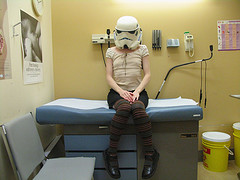10 Things We Learned From Time’s Analysis Of Why We Pay So Darn Much For Healthcare Image courtesy of (RedandJonny)
If you have some time this weekend, sit down and read the fantastic cover story in this week’s Time magazine, “Bitter Pill.” In it, Steven Brill lays out over 36 print pages (11, when laid out for the web) a core question that no one really ever asks in the course of the debate over health care in this country: why are our bills so high? More importantly, why are our bills so high when only un- or underinsured middle-class people seem to pay the sticker price for their medical care?
We’ve interspersed the facts with cat pictures, because everyone is tired of talking about health care by now. Time doesn’t do their readers the same favor, but we do still recommend that you go RTFA (read the full article…what did you think we meant?)
1. Most other developed countries spend about 10% of their gross domestic product on health care; the U.S. spends 20%. The total amount that we spend on health care is more than Japan, Germany, France, China, the U.K., Italy, Canada, Brazil, Spain and Australia combined.
2. Every hospital has what’s called a chargemaster, or a massive computer file that lists every product and service the hospital offers and how much it costs. These are the scary “list” prices that uninsured patients see on their bills.
3. Medicare calculates its reimbursements based on the costs (including overhead) of the product or service. Medicare prices are much lower than the chargemaster price, as you can imagine.
Insurance companies prefer to negotiate their reimbursements starting with Medicare’s price as an anchor point, but mergers in the health care field have left insurers in a weaker bargaining position. They end up negotiating for a given percentage off the chargemaster price instead.
4. How much does being cautious cost you? A 64-year-old unemployed Connecticut woman went to the emergency room to have her chest pains checked out, and her tab was $21,000. She hired a medical billing advocate to negotiate for her at $97 per hour, and got the total amount she had to pay down to half.

(kakissel)
5. The vice president of payer relations at one hospital told Time that this system is totally fair:
It’s fair because everyone gets the same bill. Even Medicare gets exactly the same charges that this patient got. Of course, we will have different arrangements for how Medicare or an insurance company will not pay some of the charges or discount the charges, but everyone starts from the same place.
This makes sense, as long as you assume that an unemployed sales clerk has the same negotiating power and leverage as a major insurance company or the federal government.
6. Pharmaceutical companies offer charity-care programs for patients who are uninsured and can’t afford to pay cash, but not all hospitals or physicians will bring this to patients’ attention.

(matneym)
7. Overall, not-for-profit hospitals have a higher profit margin than for-profit hospitals.
8. Medicare aggressively negotiates prices on everything except pharmaceuticals and durable medical equipment like walkers and canes. That’s because Congress passed laws specifically prohibiting it.
9. The Affordable Care Act (okay, “Obamacare”) originally contained provisions for medical researchers to study whether treatments that cost more are necessarily more effective, but Congress restricted this research from actually being used to make decisions about treatment or coverage. Which was kind of the point.
10. Like many parts of the federal government, Medicare’s staff largely consists of private contractors. There are 8,500 of them, compared to 700 civil servants.
What does Brill suggest as solutions for the problem? Health care prices are far too complex for any mere journalist to resolve, but he has a few ideas. They are, to be blunt, utter fantasies because of the political and financial power that companies in the health care sector wield, but why not dream?
- Use antitrust laws to prevent any one entity from dominating health care in a region: mergers, hospitals buying up doctors’ practices, all of it.
- Put a tax surcharge on hospital administrator salaries, and tax the profits that not-for-profit hospitals earn at 75%.
- Outlaw the chargemaster: make hospital bills reflect reality. Chargemaster prices are onerous for the uninsured middle-class patients who actually have to pay them, but make everyone else feel great because they see such a massive discount off the sticker price when they receive an Explanation of Benefits from their insurance company in the mail.
- Change patent law to limit drug profits. Don’t remove the incentive to research and manufacture new drugs, but make it a little less exorbitant.
Bitter Pill: Why Medical Bills Are Killing Us [Time]
Want more consumer news? Visit our parent organization, Consumer Reports, for the latest on scams, recalls, and other consumer issues.





